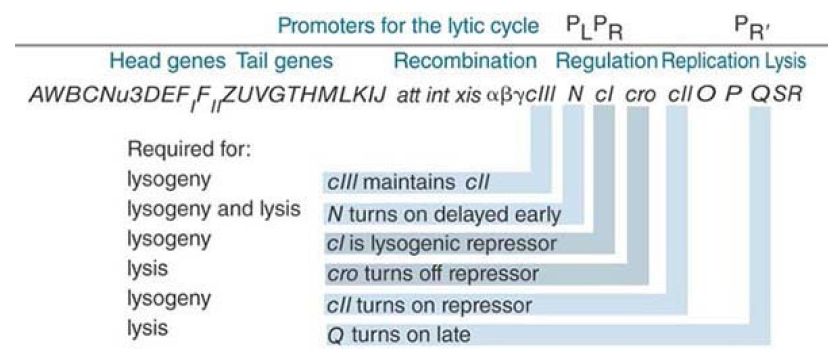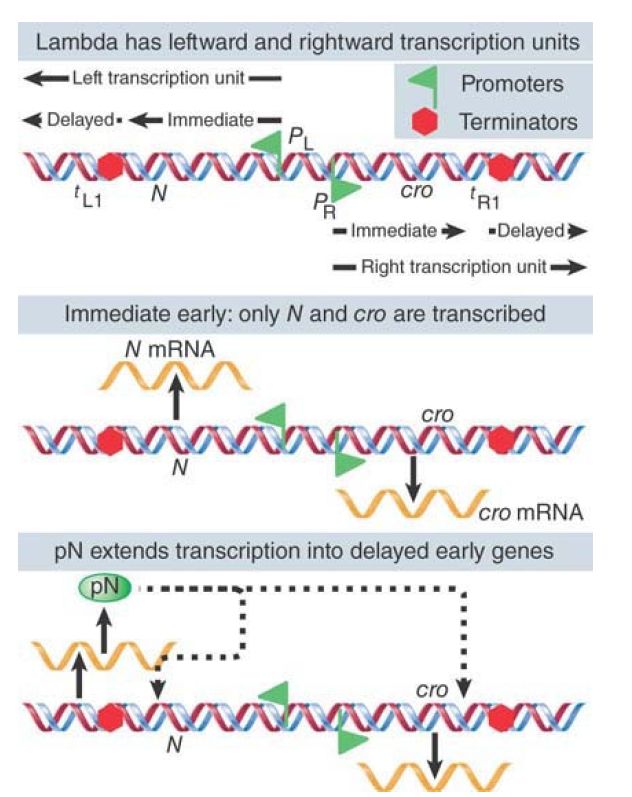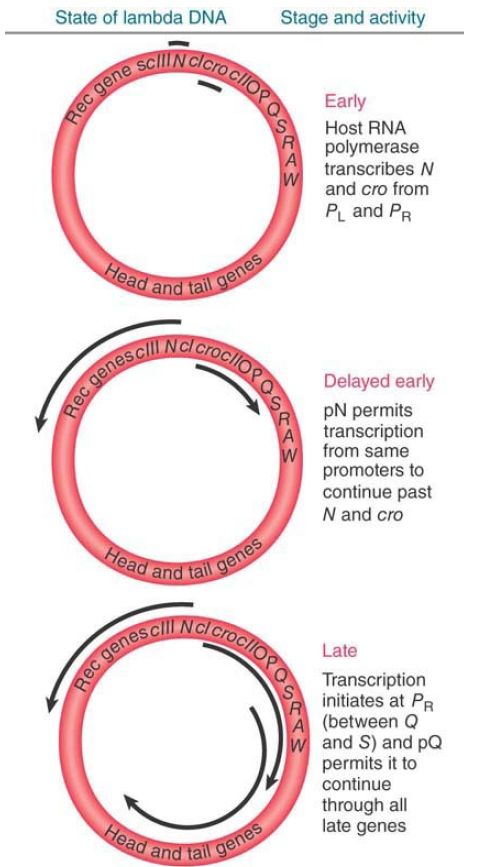
The Lytic Cycle Depends on Antitermination by pN
 المؤلف:
JOCELYN E. KREBS, ELLIOTT S. GOLDSTEIN and STEPHEN T. KILPATRICK
المؤلف:
JOCELYN E. KREBS, ELLIOTT S. GOLDSTEIN and STEPHEN T. KILPATRICK
 المصدر:
LEWIN’S GENES XII
المصدر:
LEWIN’S GENES XII
 الجزء والصفحة:
الجزء والصفحة:
 6-6-2021
6-6-2021
 2411
2411
The Lytic Cycle Depends on Antitermination by pN
KEY CONCEPTS
- pN is an antitermination factor that allows RNA polymerase to continue transcription past the ends of the two immediate early genes.
- pQ is the product of a delayed early gene and is an antiterminator that allows RNA polymerase to transcribe the late genes.
- Lambda DNA circularizes after infection; as a result, the late genes form a single transcription unit.
To disentangle the lytic and lysogenic pathways, let’s first consider just the lytic cycle. FIGURE 1 gives the map of lambda phage DNA. A group of genes concerned with regulation is surrounded by genes needed for recombination and replication. The genes coding for structural components of the phage are clustered. All of the genes necessary for the lytic cycle are expressed in polycistronic transcripts from three promoters.

FIGURE 1 The lambda map shows clustering of related functions. The genome is 48,514 bp.
FIGURE 2. shows that the two immediate early genes, N and cro, are transcribed by host RNA polymerase. N is transcribed toward the left and cro toward the right. Each transcript is terminated at the end of the gene. The protein pN is the regulator, the antitermination factor that allows transcription to continue into the delayed early genes by suppressing use of the terminators tL and tR . In the presence of pN, transcription continues to the left of the N gene into the recombination genes and to the right of the cro gene into the replication genes.

FIGURE 2 . Phage lambda has two early transcription units. In the “leftward” unit, the “upper” strand is transcribed toward the left; in the “rightward” unit, the “lower” strand is transcribed toward the right. Genes N and cro are the immediate early functions and are separated from the delayed early genes by the terminators. Synthesis of N protein allows RNA polymerase to pass the terminators tL1 to the left and tR1 to the right.
The map in Figure 1 gives the organization of the lambda DNA as it exists in the phage particle. Shortly after infection, though, the ends of the DNA join to form a circle. FIGURE 2 shows the true state of lambda DNA during infection. The late genes are welded into a single group, which contains the lysis genes S–R L1 R1 from the right end of the linear DNA and the head and tail genes A– J from the left end.

FIGURE 3. Lambda DNA circularizes during infection, so that the late gene cluster is intact in one transcription unit.
The late genes are expressed as a single transcription unit, starting from a promoter P that lies between Q and S. The late promoter is used constitutively. In the absence of the product of gene Q (which is the last gene in the rightward delayed early unit), however, late transcription terminates at a site t . The transcript resulting from this termination event is 194 bases long; it is known as 6S RNA. When pQ becomes available, it suppresses termination at t and the 6S RNA is extended, with the result that the late genes are expressed.
 الاكثر قراءة في مواضيع عامة في الاحياء الجزيئي
الاكثر قراءة في مواضيع عامة في الاحياء الجزيئي
 اخر الاخبار
اخر الاخبار
اخبار العتبة العباسية المقدسة


